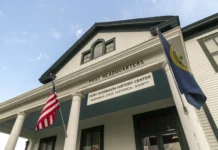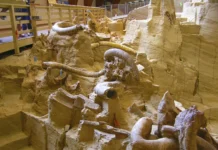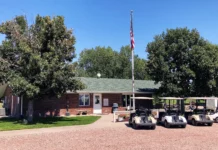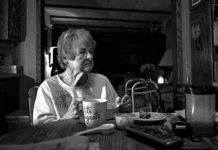| NEBRASKA |
The wind gently blows through the prairie nearly every day. Residents of the Nebraska panhandle are used to it. Some even enjoy the breeze rustling through their hair as they contemplate history on a small, concrete bench. Here, in this quiet section of western Nebraska, a cemetery and ruins of a church are all that remain of a once-thriving Black community.
By: Irene North
Published May 16, 2022
At the turn of the 20th Century, newspapers rarely commented on the Black community in western Nebraska unless it was related to crime. Their history is largely erased from the landscape. Still, the Sheep Creek Cemetery is a testament to a group of educated and successful people who tried to make a home on the border of Nebraska and Wyoming.
In September 1908, brothers Radford and Joseph Speese arrived in the Spoon Hill Creek area in northern Laramie County, Wyoming, 15 miles northeast of Torrington, to claim their homesteads. Their parents had been slaves in North Carolina. The Taylor families arrived soon after.
They were among many Black people who decided to move west for freedom and a better life. They had been prosperous in central Nebraska and members of second-generation free Blacks. They wanted to escape the cruelty of Jim Crow laws and hoped Wyoming’s passage of women’s suffrage signaled they would also be welcomed. The town of Empire, Wyoming, was built on that hope.
.
In 1908, two more Speese brothers, John and Charles, joined the growing community. Despite not using irrigation and little water, the Torrington Telegram newspaper reported in 1911 that Joseph Speese “raised more Irish potatoes than many of the farmers under irrigation.” In 1912, he won first place at the county fair for sweet corn, popcorn, potatoes, millet, cucumbers, muskmelon, and field peas.
By that year, the Sheep Creek area boasted a Black community of more than 30 people living in the area, including women who “claimed or purchased and paid taxes on their land and livestock.”
Blacks and whites lived together, working the land and enjoying a quiet life.
The death of Baseman Taylor, a member of Empire’s most prominent families, in police custody in 1913, which Historian Todd Guenther called a lynching, was considered the worst in a string of racially-based incidents within the community. Taylor was shackled by hand and foot at the time of his death.

A baby girl in the community died during the construction of a Presbyterian church in 1915. She was buried directly east of the church door, across the road. Not long after, Mrs. Otis Taylor (Leota Speese) passed away. With Mrs. Taylor’s passing, the people of Empire saw a need for a cemetery, and Taylor’s brother donated 20 acres of his property across the road to creating a cemetery.
Around the same time as the building of the Presbyterian church, August Wallman and Hubert Haycraft built a Baptist church about one mile north, near the banks of Sheep Creek. Haycraft served as pastor, and the creek was dammed during baptismal services.
Russell Taylor taught school in Empire, though some people refused to send their children there because they would not send them to a school “where they would be told what to do.” Taylor was not deterred. He also ministered in the local integrated Grace Church, which boasted 44 members in 1916.

All that remains of that once hopeful time is the ruins of the Sheep Creek Presbyterian Church and the Sheep Creek Cemetery, which lie just over the Wyoming border in Henry, Nebraska. The town’s goal was to become self-sufficient and autonomous, but the town was abandoned in less than two decades and disappeared from the landscape by the mid-1920s.
The town’s isolation, widespread drought, and the economics in America after World War I, which saw banks and homesteaders go broke, forced people to move on in search to find a way to survive. Racism from the surrounding communities that refused to purchase Black-owned products or shop in Black-owned businesses contributed to the town’s quick decline.
Joseph and Lizzie Speese’s farm was foreclosed in an official announcement in the Goshen County Journal on August 18, 1921.
While Empire never experienced substantial growth boasting a population of 50 families at its peak, historian Todd Guenther attests the town contributed to the growth of nearby Torrington and Mitchell, with Empire residents purchasing their goods and selling their crops and produce in the towns.
By 1930, only four people in Goshen County, Wyoming, were Black.

The entire town was gone, but the Sheep Creek Cemetery reminds us of the people who dreamed of a place for racial equality.
The cemetery, still in use today, holds the remains of several Empire residents, including two unidentified African-American boys. Two marked graves are located outside of the boundaries of the cemetery. Inside the cemetery, a marble plaque reads, “In memory of the known and unknown.”
A small brochure, available for free to visitors, indicates the known graves at Sheep Creek. Arther Davidson’s grave has the oldest headstone still standing. He was born on June 4, 1921, and died on April 15, 1927, the victim of an accidental gun shooting.
Mrs. Barney Holcomb was riding in a buggy when it tipped over into Sheep Creek, breaking her neck. She was buried next to her good friend, Mrs. Taylor. Robert Eugene Smith was born stillborn on December 27, 1933.
But many of the graves will never be positively identified. Several burials were without service and little information on the buried people there. There are graves of several babies, including unnamed Black children from Empire.
Today visitors can rest on one of two cement benches in the cemetery and imagine a thriving community going about their daily tasks as they go to church, visit the post office, or have a quiet picnic in a field. Cattle graze in these fields, unaware of the vibrant life that once held many hopes and dreams. Swainson’s hawks, red-tail hawks, and birds of smaller varieties keep watch from the air and in the trees.
As visitors close their eyes and listen, they can hear birds chirping as they fly and play with other birds in the morning sunlight and imagine the original settlers here, too, were entertained by the birds of the Great Plains.
Still, the area has a feeling of hope. Life is everywhere around Sheep Creek Cemetery and, for a brief moment in time, visitors can relax and remember what it is like to dream. As the cattle graze upon the spring grass, the Sheep Creek Cemetery holds steadfast, a connection to the past, a remembrance of dreams, an honoring of our ancestors, and a testament to what people can achieve when they work together.
| FINDING SHEEP CREEK CEMETERY AND RUINS
Sheep Creek Presbyterian Church and Sheep Creek Cemetery are on Henry Road in Henry, Nebraska.
From Scottsbluff, Nebraska: travel west on US Highway 26 for 21.2 miles to Henry Road in Henry. The turn is directly across the street from a large, steel building. Turn right (north) onto Henry Road and travel approximately 6.6 miles.
From Torrington, Wyoming, travel east on US Route 26 for approximately 8.5 miles, then turn left (north) onto Henry Road. The cemetery is located on the east side of the road.
| SOURCES AND MORE INFORMATION
Robert Galbreath, “Empire, Wyoming,” (August 2016), https://www.historicwyoming.org/profiles/empire-wyoming
Robert Galbreath, “Making a Home in Empire, Wyoming,” (August 2016), https://www.wyohistory.org/encyclopedia/making-home-empire-wyo
Todd Guenther, “Empire Builders” http://www.nebraskahistory.org/
Todd Guenther, “The Empire Builders, An African American Odyssey in Nebraska and Wyoming,” Nebraska History 89 (2008): 176-200.
Richelle Rawlings-Carroll, “Empire, Wyoming (1908-1930)” https://www.blackpast.org/african-american-history/empire-wyoming-1908-1930/
Helen Spencer, Pamphlet available to visitors at Sheep Creek Cemetery.
Edited by: Toni Warburton
















